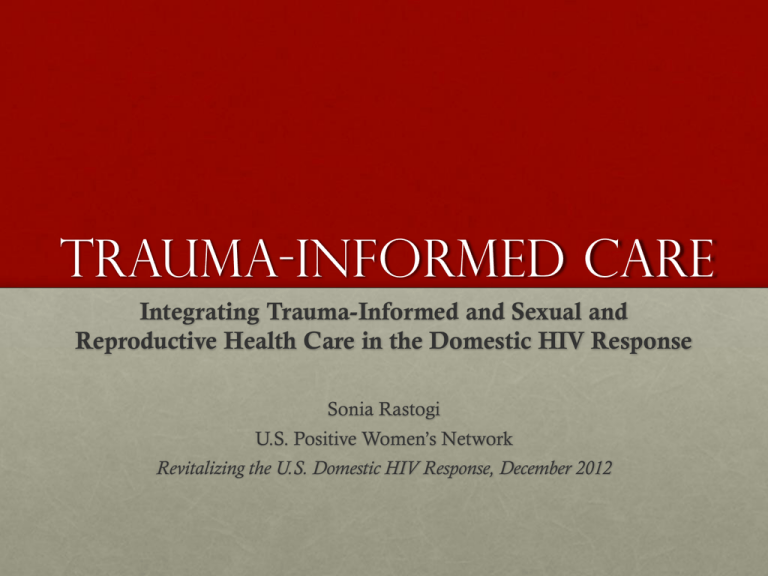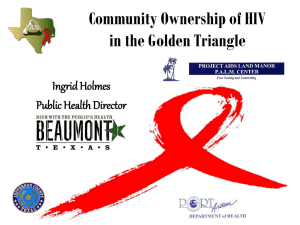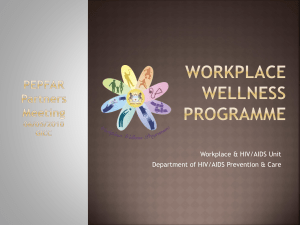
Trauma-informed care
Integrating Trauma-Informed and Sexual and
Reproductive Health Care in the Domestic HIV Response
Sonia Rastogi
U.S. Positive Women’s Network
Revitalizing the U.S. Domestic HIV Response, December 2012
Poorer health outcomes
• HIV-positive Black women have
life expectancies that are approx.
6 years shorter than HIV-positive
white men due to late initiation
and early discontinuation of ART,
and higher rates of concurrent
health and psychosocial issues
(2009)
• HIV-positive women have 20%
higher death rates, higher rates
of hospitalization, and twice as
many HIV-related and AIDS
defining illnesses per person than
their male counterparts
• Where is the data on trans
women?
Women and HIV Factsheet, July 2012,
Kaiser Family Foundation
Why?
• Rate of Intimate Partner Violence: 55% among women
living with HIV, double the national rate of 24.8%
• Rates of Childhood Sexual Abuse and Childhood
Physical Abuse: 39% and 42% respectively among
women living with HIV, more than twice the national
rates of 16.2% and 22.9%
• Rate of Lifetime Sexual Abuse: 61% among women
living with HIV, over 5 times the national rate of 12%
• Rate of Post-traumatic Stress Disorder: 30% among
women living with HIV, almost 6 times the national rate
of 5.2%
Source: Machtinger et al., Psychological Trauma and PTSD in HIV-positive Women: a Meta-Analysis, November 2012, AIDS
Behavior
“Convergence of
forces”
• HIV criminalization laws
• Criminalizing the sexuality of women living with and
at risk of HIV
• Transphobia & Homophobia
• Poverty
• High rates of incarceration in communities of color
• Politically disenfranchised: lowest voter turnout, voter
ID laws
Impact
• Impaired sexual decisionmaking
• Four-fold increase in
STIs
• Higher likelihood of
substance use in one’s
lifetime
• Depression, PTSD,
anxiety, chronic stress
Impact: Compromised
immunofunction
• Increased prevalence of stress, depression, and chronic anxiety
• Reduced CD4 counts and other HIV biomarkers due to PTSD
and depression
• Associations between altered red blood cell and decreased T-cell
function
• Associations between violence and hypothalamic-pituitaryadrenal axis functioning (greater occurrence of altered levels of
cortisol and dehydroepiandrosterone)
• Altered neuropsychological functioning that can negatively impact
immune responses to HSV infection
• Relationship between stress and other psychosocial factors with
faster disease progression among people living with HIV
Source: Campbell et al., The intersection of intimate partner violence against women and HIV/AIDS: a review, December 2008,
International Journal of Injury Control and Safe Promotion
Living with HIV is
traumatic
Intimate Partner
Violence: stigma,
disclosure, isolation,
fear, isolation,
depression, PTSD
Health &
Wellbeing
Community-based
Violence:
homophobia,
transphobia, stigma
& discrimination
when receiving
services, etc.
Institutional
Violence: HIV
criminalization
laws, War on
Women, employer
discrimination, etc.
UCSF Women’s HIV
Program
Peer-based support:
common threads
• Small group (8-12) HIV
prevention training
organized around
intensive, interactive, skillbuilding sessions
• Designed to enhance the
ability of women living
with HIV to understand
and share life experiences
including HIV and
trauma
Peer-based support:
WORLD
• Phoenix Project: short
pilot project in 2010 to reengage/link women who
had fallen out of care
• Identified 25 women out
of care; successfully
linked 17
• BANPH
• Ryan White model
A Nationally
recognized issue
“The research needs of integrated care
in mental health has moved past
demonstration of efficacy to address
issues of implementation,
effectiveness, sustainability, utilization of
technology to reduce costs, extension of
the successful
integrated care models to specialty
mental health settings, and to clinical
conditions beyond
depression.”
A Nationally
recognized issue
A Nationally
recognized issue
A Nationally
recognized issue
The memorandum calls for “integrating of sexual and reproductive health services,
gender-based violence services, and HIV/AIDS services, where research
demonstrates that doing so will result in improved and sustained health outcomes.”
At the end of the day…
• Trauma impacts everyone (similar and distinct traumas of queer
and trans men)
• Trauma keeps people off their medications. Focus on the
treatment cascade by first working through trauma and stigma.
• Violence against women and trauma are inextricably linked with
sexual and reproductive health and justice
• The risk of higher costs if we do not address the glaring issues in
the lives of people living with HIV
• Beyond screening: trauma-informed care 2.0
• Enthusiastically address structural, psychosocial, and behavioral
factors
Recommendations to
amend the NHAS
• Identify, support, and resource trauma-informed demonstration projects
that address violence against women and the impact of trauma in
women’s lives
• Identify emerging and bolster existing advocacy and policy efforts that
combat the structural root causes that put all women at risk for HIV in
the first place
• Identify and craft strategic entry points into the ACA and Medicaid
expansion for the Ryan White Care Model to be adapted into primary
care and care for chronic diseases
•
•
Meaningful and thoughtful integration of peer services & interventions
Training and capacity building to recognize, articulate, triage, and address trauma
• Investing in research
•
•
•
•
Investment in female-initiated and female-controlled prevention options
Investment in understanding the physiological impacts of trauma
Investment in understanding the hidden health care costs of stigma (how much are
we spending on health care that does not recognize or address stigma)
Investment in operational science and implementation science (opportunity to build
from the ground level)
Sources
•
Campbell et al., The intersection of intimate partner violence against women and HIV/AIDS: a
review, December 2008, International Journal of Injury Control and Safe Promotion
•
Briefing Paper: Ending HIV-related Health Care Disparities for Women, March 2012, 30 for 30
Campaign
•
Women and HIV Factsheet, December 2012, Kaiser Family Foundation
•
Violence Against Women and Trauma Factsheet, U.S. Positive Women’s Network, December 2012
•
Machtinger et al., Psychological Trauma and PTSD in HIV-positive Women: a Meta-Analysis,
November 2012, AIDS Behavior
•
Fried, S. and Kelly, B., Gender, Race + Geography = Jeopardy: Marginalized Women, Human Rights
and HIV in the U.S., July 2011, Women’s Health Issues: Special Supplement
•
Machtinger et al., Recent Trauma is Associated with Antiretroviral Failure and HIV Transmission
Risk Behavior Among HIV-positive Women and Female-identified Transgenders, AIDS Behavior,
November 2012
•
Losina et al., Racial and sex disparities in life expectancy losses among HIV-infected persons in the
United States: impact of risk behavior, late initiation, and early discontinuation of antiretroviral
therapy, Clinical Infectious Diseases: an official publication of the Infectious Diseases Society of
America, October 2009








